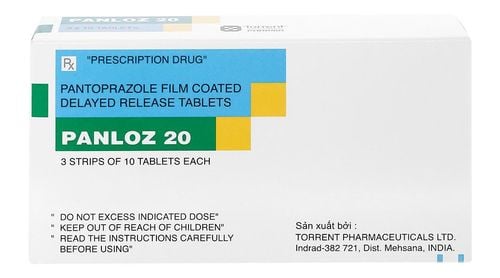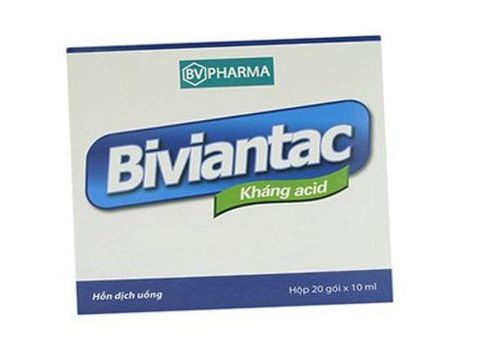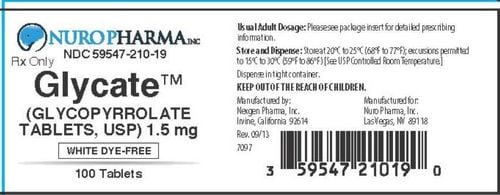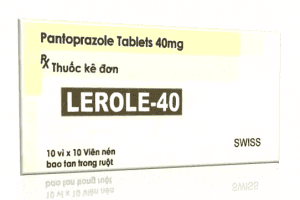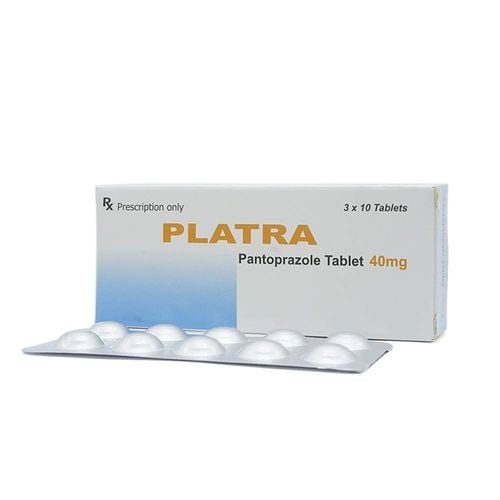This is an automatically translated article.
Cadipanto medicine has the main active ingredient is Pantoprazole, this is a substance that has the main effect in inhibiting gastric acid secretion, helping to treat diseases caused by increased acidity and heal wounds in the digestive tract quickly.
1. What are the uses of Cadipanto?
Cadipanto medicine has the main ingredient is Pantoprazole 40mg, prepared in hard capsule form. Pantoprazole is a selective proton pump inhibitor. Pantoprazole is irreversibly bound to H+/K+ATPase, an enzyme system present on the surface of the parietal cells of the stomach, so that Pantoprazole can inhibit the final transport of hydrogen ions into the stomach.
Pantoprazole has the effect of inhibiting the production of H + even in the normal state and when the body is stimulated by any stimulus such as stress, drugs, food... The degree of inhibition of secretion Stomach acid depends on the dose and duration of treatment. In addition, Pantoprazole can prevent HP bacteria (Helicobacter pylori) in people with peptic ulcers infected with this bacteria, so in the HP eradication regimen, Pantoprazole can increase the effectiveness in reducing gastritis. Thickness caused by H. pylori.
2. Indications and contraindications of the drug Cadipanto
Indications:
The drug Cadipanto specifically inhibits the proton pump, reducing gastric acid secretion. So Cadipanto is indicated in the following cases:
Patients with peptic ulcer disease. Symptoms associated with gastroesophageal reflux disease. Tablets are often used in combination with 2 suitable antibiotics to kill H. pylori in patients with peptic ulcers to heal ulcers and prevent recurrence caused by bacteria. Cadipanto is contraindicated in the following cases:
Hypersensitivity or allergic reaction to Pantoprazole or to other components of the drug. Children under 18.
3. Usage and dosage of Cadipanto
How to use:
Cadipanto is made in the form of hard capsules, taken orally, should be taken with filtered or boiled water. Note that you do not take the drug with alcohol because it can affect the effect of the drug. It is recommended to drink this 30 to 60 minutes before eating. Dosage:
Combined in HP eradication regimen: In cases of patients with gastric ulcer and duodenal ulcer, infected with H. pylori, using appropriate therapeutic methods to destroy the bacteria can be used. can be used according to the following regimens:
Regimen 1: Take 2 times a day x (40mg Pantoprazole + 1000mg Amoxicillin + 500mg Clarithromycin) x 7 days. Regimen 2: Take 2 times/day x (40mg Pantoprazole + 500mg Metronidazol + 500mg Clarithromycin) x 7 days. Regimen 3: Take 2 times/day x (40mg Pantoprazole + 1000mg Amoxicillin + 500mg Metronidazol) x 7 days. Gastroesophageal reflux disease (GERD): Take 1 tablet daily for 4 to 8 weeks, can take more if needed.
Peptic ulcer: Take 1 tablet daily for 4 weeks and if necessary, take more.
For patients with severe liver failure: When used, the dose should be reduced. In addition, for patients with liver failure, liver enzymes should be monitored during therapy. If liver enzyme values increase, stop taking Pantoprazole.
Renal failure and the elderly: Do not take more than 1 tablet per day. The exception is when using combination therapy for the eradication of H.pylori.
4. Undesirable effects of the drug Cadipanto
When using Cadipanto medicine can cause some unwanted effects such as:
Headache or mild diarrhea are common but rarely have to stop the drug. Rarer cases include: Nausea, upper abdominal pain, feeling of bloating, skin rash, itching and dizziness. Very rarely, edema, drug fever, thrombophlebitis have occurred. During the use of Cadipanto, if you experience the above symptoms or any unusual signs suspected of taking the drug, you should notify your doctor for advice on reducing the dose or having the most appropriate treatment instructions.
5. Notes when using Cadipanto
Before using anti-secretory drugs, including Cadipanto, it is necessary to ensure that there is no gastric ulcer due to malignancy or malignant esophagitis. Use with caution in the elderly, in patients with severe hepatic impairment. Pregnant women and women who are breast-feeding should not use Cadipanto because there are no clear studies on the drug on this subject, the drug may have an adverse effect on the fetus or breast-feeding child. Some reports on the use of Pantoprazole drug show that prolonged use increases the risk of abnormal tumors in the gastrointestinal tract, increases the risk of hypomagnesaemia; When taking the drug you have a higher risk of gastrointestinal infections, so it is advisable to ensure a hygienic diet. If the symptoms do not improve or worsen while taking the drug, you should see a doctor immediately. Drug interactions can occur when drugs are used concurrently. Some drugs that may interact with Cadipanto have been reported such as other proton pump inhibitors, Theophylline, Ketoconazole, Antipyrine, antiviral drugs Antanazavir, Diclofenac, Diazepam... Store Cadipamto in a cool, dry place at below temperature. 30°C, protect from light and keep out of reach of children. Above is all information about the uses, dosage and precautions when using Cadipanto. Cadipanto is used under the direction of a doctor, you need to take it exactly as directed to ensure safety and effectiveness.





